 |
 |
|
 |
 |
Pentax Full Frame K-1-series
2016, April: The FF Pentax K-1: TIPA prize winner
2016! It has been a long time waiting for a Full Frame DSLR from Pentax. But during early spring 2015 it was finally announced, and from late April 2016 it is here. True to Pentax philosophy, this is for the advanced amateurs, not the most
demanding pros. Not that it does not deliver images of high quality, because it does indeed, but price level is moderate, and the variety of extra gear is still not where the action shooting pros would like it to be. They may also demand more frames per second,
as one thing.
Since 1969, though, when the 6x7 was introduced, Pentax has delivered cameras for the pros. Together with the 645, that was introduced in 1984, the 6x7 and 67 has been the tools of numerous professionals, especially in studios and on location.
Bigger format deliver better images, therefore medium format has been Pentax' answer. So, for everyone except the extreme action shooters, Pentax is there. And the K-1 is narrowing the gap.
This is already recognized internationally, as the K-1
is a 2016 TIPA prize winner!
AND: Pentax K-1 is gaining much praise for its pixel shift system, among other things. Tests show that it outperforms most cameras, even those at far higher price ranges! (DPReview)
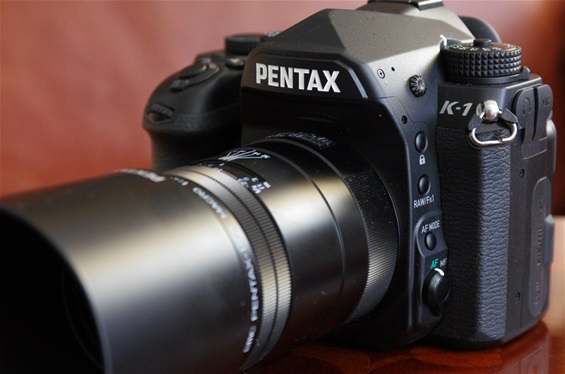 Pentax K-1.. Yes, it's here!
Pentax K-1.. Yes, it's here!
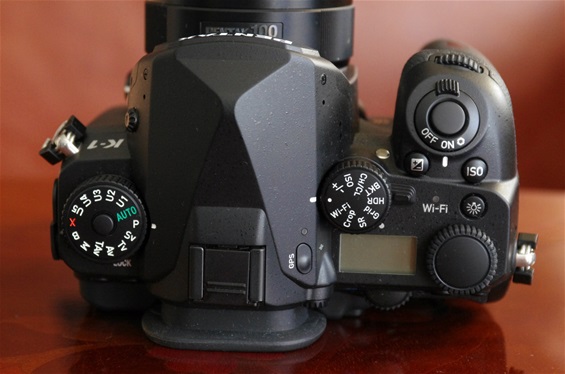 A new design. Programs and user modes to the left, as before. But look to the right! Two new dials for faster access to vital functions. Ten options on the dial in front, and a set wheel to the right. Which leaves less room for the information window. And the pop up flash is gone. (Like on the K-3 II.)
Serial number (Sn): 6354475.
A new design. Programs and user modes to the left, as before. But look to the right! Two new dials for faster access to vital functions. Ten options on the dial in front, and a set wheel to the right. Which leaves less room for the information window. And the pop up flash is gone. (Like on the K-3 II.)
Serial number (Sn): 6354475.
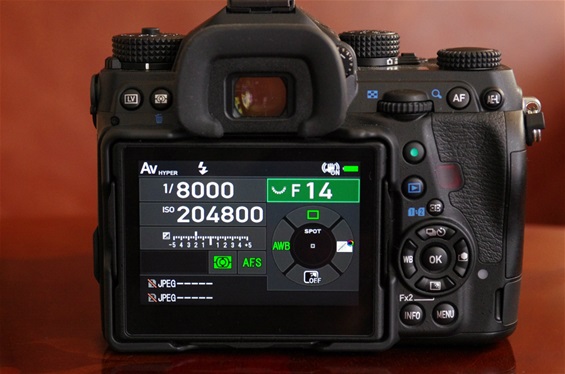 With this LCD panel on the back, the need for a big window on the top is gone. Note the 204800 ISO value. Not without noise, but it gives you a picture when it would otherwise be black.
With this LCD panel on the back, the need for a big window on the top is gone. Note the 204800 ISO value. Not without noise, but it gives you a picture when it would otherwise be black.
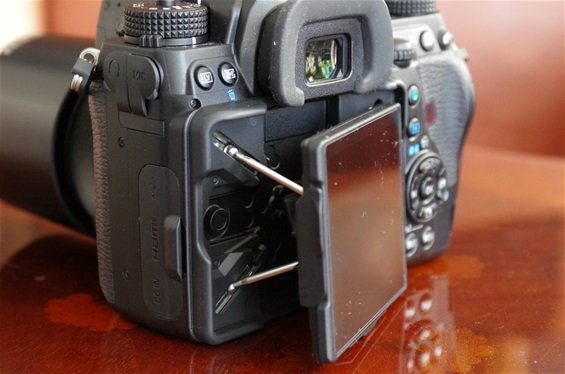 The rear information screen can be tilted in any direction.
The rear information screen can be tilted in any direction.
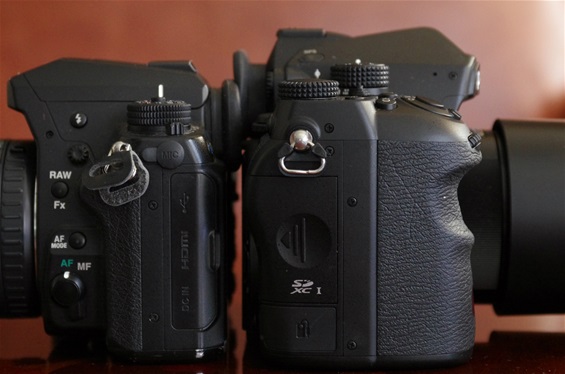 The K-3 to the left, K-1 to the right. Substantially bigger, but still a dream to hold! K-3: 784 grams. K-1: 982 grams. Both with battery and one card.
The K-3 to the left, K-1 to the right. Substantially bigger, but still a dream to hold! K-3: 784 grams. K-1: 982 grams. Both with battery and one card.
 The difference in size.
The difference in size.
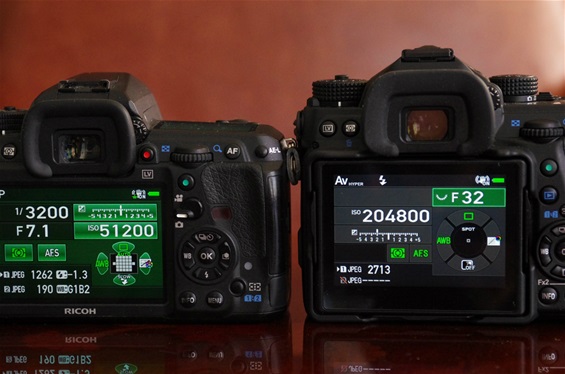 Some changes to the information panel. AND: ISO values up to 204800 compared to the 51200 for the K-3.
Some changes to the information panel. AND: ISO values up to 204800 compared to the 51200 for the K-3.
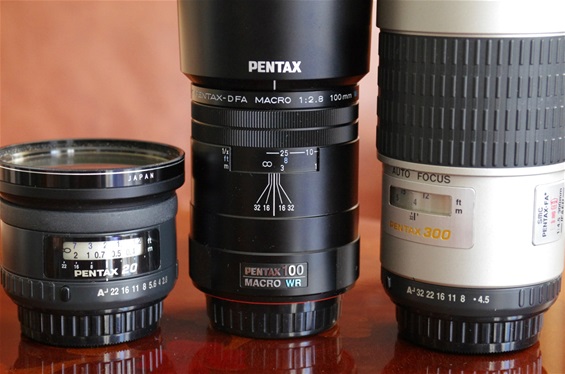 Three of the many primes available for Pentax K- mount full frame: FA 20/2,8, D FA 100/2,8 Macro and FA* 300/4,5.
Did you know that there are probably more than 300 K-mount lenses to choose from? (Other makes included)
Three of the many primes available for Pentax K- mount full frame: FA 20/2,8, D FA 100/2,8 Macro and FA* 300/4,5.
Did you know that there are probably more than 300 K-mount lenses to choose from? (Other makes included)
Lenses for K-1 Full Frame:
Let us look at the lenses suitable for the K-1, because there are quite a few:
Zoom lenses introduced 2015/2016 for FF:
-D FA 15-30/2,8 ED SDM WR
-D FA 24-70/2,8 ED SDM WR
-D FA 28-105/3,5-5,6
ED DC WR
-D FA* 70-200/2,8 ED DC AW
-D FA 150-450/4,5-5,6 ED DC AW
Later lenses:
-D FA 70-210/4 ED SDM WR (Jan. 2020) These are high quality lenses and cover the range between 15 - 450 mm. So, nothing is really missing here.
What
has been criticized while waiting for the camera, has been the ralatively few D FA primes available. And that is correct if one speaks of new lenses. But when including the FA lenses and the DA lenses that will work with FF, that critic looses some punch.
First the D FA lenses:
-SMC D FA 50/2,8 Macro
-SMC D FA 100/2,8 Macro
-SMC D FA 100/2,8 WR Macro
Those were the ones available at the time of release of the K-1. Then the FAs:
-FA 20/2,8, FA* 24/2, FA 28/2,8, FA Ltd 31/1,8,
FA 35/2, FA Ltd 43/1,9, FA 50/1,4, FA Ltd 77/1,8, FA* 85/1,4, FA 100/2,8, FA 135/2,8, FA* 200/2,8, FA* 300/2,8, FA* 300/4,5, FA* 400/5,6, FA* 600/4, FA 600/5,6. 17 all together.
That makes 20 FF AF primes. I haven't even mentioned all.
Are we lacking any primes?
Most of these lenses are superbe, with the * and Ltd series as leading stars. Some were produced from 1991 till 2004 for the Z and MZ cameras, some came later and are still produced. But will they do the job for a
demanding FF camera? Most of them will, according to tests. In fact, each of these 17 FA lenses scores very high (between 8,67 and 10,00 out of 10) on Pentax Forum user tests with digital cameras. The only feature missing here is the Weather Resistance.
For that purpose, we have some DA prime lenses that are officially FF ready. Those are:
- DA* 200 2,8 and DA* 300 4, DA 560 5,6.
After the release in 2016, the following lenses have been added:
-HD D FA* 50/1,4 SDM AW (A STAR-lens
from 2018)
-HD FA 35/2 (Updated SMC lens with new HD coating, from early 2019)
-HD D FA* 85/1,4 SDM AW (A STAR-lens from late 2020)
-HD FA 31/1,8 Limited (Updated with HD and SP coatings and rounded blades, from early 2021)
-HD FA 43/1,9
Limited (Updated with HD and SP coatings and rounded blades, from early 2021)
-HD FA 77/1,8 Limited (Updated with HD and SP coatings and rounded blades, from early 2021)
-HD D FA 21/2,4 ED Limited DC WR (Late 2021)
The list of K-mount lenses is long, as shown at the bottom of this page. The list contains more than 100 lens brands that have been making K-mount lenses! Although many of these brands are house brands and therefore often duplicates of others, the total
number of K-mount lenses must be far above any other mount. One can choose between modern D FA lenses and older lenses from 1975 and up. Up till now, Pentax has produced 199 lenses of K, M, A, F, FA and D FA types., plus the DA lenses suitable for FF. (K:
44, M: 30, A: 41, F: 21, FA: 44 (including FA J), D FA: 15, DA FF: 4.)
I have also presented images taken with some popular DA zoom lenses, to show where they can work, and where not. Please see DA
lenses on K-1
From looking at those test shots, I would recommend the following as a good mix if you do not have the D FA lenses:
-DA 12-24/4. Hardly any vignetting from 16-17mm. Very sharp from 5,6.
-DA 16-45/4. Very sharp at
5,6, but vignetting up to 22 mm.
(-DA* 50-135/2,8 needs cropping all the way, and will not act as a FF lens. But when cropping, making it a 70-200 lens, it is very good from 4,0, superbe from 5,6, even on heavy enlargements!)
-DA* 200 or DA* 300,
or FA* 300. (Or K 200/4 from 1975!!)
-There is also the zoom SMC DA 60-250/4 ED (IF) SDM , which is recommended for Full Frame.
2018: K-1 II:
Early 2018 Pentax released an improved K-1, the K-1 II. The differences from the first model were not many, but important to some. First of all, the noise reduction was improved, allowing ISO values up to 819 200. The high number does not mean flawless
images in the dark, not at all, but the scale is pushed upwards, giving acceptable images at higher ISO values than before. Secondly, there is the Pixel Shift Resulution II, now making it possible to take advantage of the Pixel Shift system also when
shooting freehand, while the first edition, introduced with the K-1, demanded a tripod. Finally, the continous focus has been improved, making the system faster and more accurate.
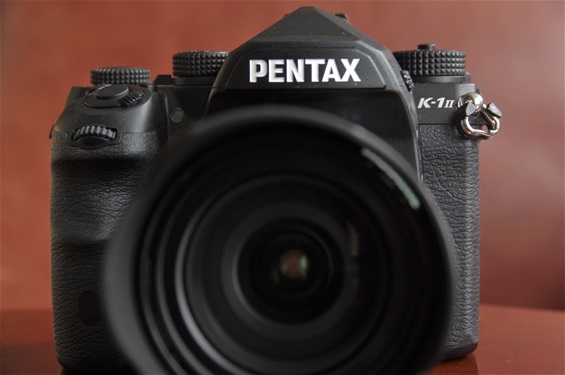 From the outside, exactly like the K-1. Only the "II" reveals the new edition. Sn. 7356756.
From the outside, exactly like the K-1. Only the "II" reveals the new edition. Sn. 7356756.
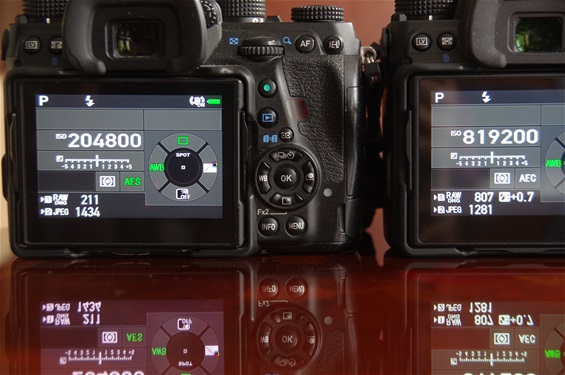 Here is the only proof of improvements that can be seen from the outside, the 2-step higher ISO value.
Here is the only proof of improvements that can be seen from the outside, the 2-step higher ISO value.
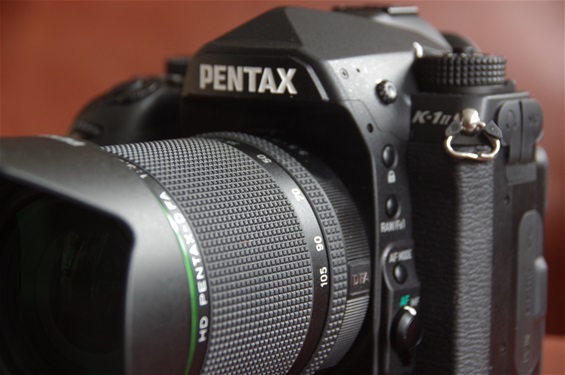 The lens range of D FA zooms goes from 15-30 via 24-70, 28-105, 70-200 to 150-450. All quality lenses, as one would expect. Here is the less expensive of them, the 28-105. Still a very good walk around lens. Sn. 4555400.
The lens range of D FA zooms goes from 15-30 via 24-70, 28-105, 70-200 to 150-450. All quality lenses, as one would expect. Here is the less expensive of them, the 28-105. Still a very good walk around lens. Sn. 4555400.
List of lenses with K-mount
List of lens brands with any K-mount variant - 1
Access
- 2 Angenieux
- 3 Agfa
- 4 Arsat
- 5 Beroflex
- 6 Braun
- 7 Carl Zeiss Jena
- 8
Carl Zeiss
- 9 Chinon
- 10 Cima Kogaku
- 11 Cosina
- 12 Cosmicar
- 13 CPC
- 14 Eikor
- 15
Focal
- 16 Gemini
- 17 Hanimex
- 18 Hervic Zivnon
- 19 Helios
- 20 Hoya
- 21 Irix
- 22
JC Penney
- 23 Kalimar
- 24 Kiron
- 25 LOMO
- 26 Lester A. Dine
- 27 Lensbaby
- 28 Loreo
- 29 Luxon
- 30 Mir
- 31
Miranda
- 32 Mitakon
- 33 Makinon
- 34 Oberon
- 35 Opteka
- 36 Ozunon
- 37 Petri
- 38
Peleng
- 39 Pentax
- 40
Phoenix
- 41 Polar
- 42 Porst
- 43 Promaster
- 44 Quantaray
- 45 Revue
- 46 Revu
- 47
Revuenon
- 48 Ricoh - Rikenon - Riconar
- 49
Rokinon
- 50 Sakar
- 51 Samyang
- 52 Samsung
- 53 Schneider-Kreuznach
- 54 Sears
- 55Sigma
- 56 Soligor
- 57 Spiratone
- 58 Sun
- 59 Sunagor
- 60 Suntop
- 61 Takumar
- 62 Tamron
- 63 Tokina
- 64 Tou/Five Star
- 65
Venus Optics
- 66 Vivitar
- 67
Cosina Voigtländer
- 68 VOMZ
- 69 Zenitar
In addition to this I found the following lens brands with K mount on eBay on December 22nd 2021: - 70 Albinar K 28 2,8
- 71 Sirius K 28 2,8.
- 72 Meyer Gorlitz K 35 2,8.
- 73 Deitz 500-8.
- 74 Itorex 80-200 4,5.
- 75 Star-D 135 2,8
- 76
Osawa 135 2,8
- 77 Chinar 135 4,5
- 78 Kelda 500 8
- 79 Oshiro 500 6,3
- 80 Laowa 100 2,8 (Produced
by Venus Optical)
- 81 Tokura 80-200 4,5
- 82 Aston 28 2,8
- 83 Katana 80-200 4,5
- 84 Elicar
90 2,5
- 85 Sicor 80-200 4,5
- 86 Prospec 28 2,8
- 87 Zykkor 28 2,8
- 88 Mirage 35 2,8
- 89 Magnicon 35-70 3,5 4,8
- 90 Camura 28 2,8
- 91 Cimko 80-200 4,5 (Cima Kogaku)
- 92 Bower 500
8
- 93 RKN (Rokinon?) 35-70 3,5-4,5
- 94 Saitex 28-75 3,5-4,5
- 95 Exacta Varioplan 35-70 3,5-4,5
- 96
Lentar 28 2,8
- 97 PMZ 80-200 4,5
- 98 Expert 80-205 4,5
- 99 Paragon 35 2,8
- 100 Ensinor 135
2,8
- 101 Kitstar 200 3,5
- 102 Coastar 28 2,8
- 103 Owen 200 3,5
- This is how far I got going
through 1650 K-mount listings on one evening. There are some 4500 listings altogether! However, some are listed several times.
|
|
 |
|
|
|